Rosetta preparing for perihelion
13 July 2015
Rosetta's investigations of its comet are continuing as the mission teams count down the last month to perihelion – the closest point to the Sun along the comet's orbit – when the comet's activity is expected to be at its highest.
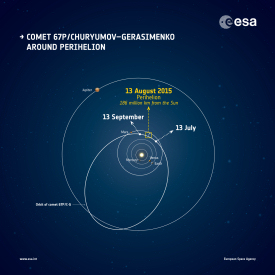 |
|
Comet 67P/C-G around perihelion. Credit: ESA |
Rosetta has been studying Comet 67P/Churyumov-Gerasimenko for over a year now, with observations beginning during the approach to the comet in March 2014. This included witnessing an outburst in late April 2014 and the revelation of the comet's curious shape in early July.
After arriving at a distance of 100 km from the double-lobed comet on 6 August, Rosetta has spent an intense year analysing the properties of this intriguing body – the interior, surface and surrounding dust, gas and plasma.
Comets are known to be made of dust and frozen ices. As these ices are warmed by the Sun, they turn directly to vapour, with the gases dragging the comet's dust along with it. Together, the gas and dust create a fuzzy atmosphere, or coma, and often-spectacular tails extend tens or hundreds of thousands of kilometres into space.
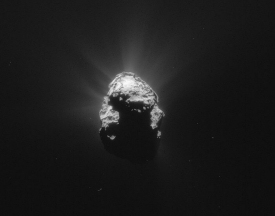 |
| Comet 67P/C-G on 25 June 2015 - NavCam. Credit: ESA/Rosetta/NAVCAM, CC BY-SA IGO 3.0 |
While ground-based observations can monitor the development of the coma and tail from afar, Rosetta has a ringside seat for studying the source of this activity directly from the nucleus. One important aspect of Rosetta's long-term study is watching how the activity waxes and wanes along the comet's orbit.
The comet has a 6.5 year commute around the Sun from just beyond the orbit of Jupiter at its furthest, to between the orbits of Earth and Mars at it closest.
Rosetta rendezvoused with the comet around 540 million km from the Sun. Today, 13 July, a month from perihelion, this distance is much smaller: 195 million km. Currently travelling at around 120 000 km/h around their orbit, Rosetta and the comet will be 186 million km from the Sun by 13 August.
"Perihelion is an important milestone in any comet's calendar, and even more so for the Rosetta mission because this will be the first time a spacecraft has been following a comet from close quarters as it moves through this phase of its journey around the Solar System," notes Matt Taylor, ESA's Rosetta project scientist.
"We're looking forward to reaching perihelion, after which we'll be continuing to monitor how the comet's nucleus, activity and plasma environment changes in the year after, as part of our long-term studies."
See our FAQ below for more on what can you expect from perihelion and the activities planned around it.
Perihelion basics
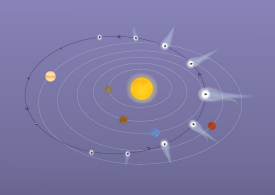 |
| Comet 67P/C-G's orbit. Credit: ESA |
What is perihelion exactly?
Perihelion is the closest point a Solar System object gets to the Sun along its orbit (aphelion is the term given to the most distant point). The term derives from ancient Greek, where 'peri' means near and 'helios' means Sun.
How close to the Sun will the comet be at perihelion?
Comet 67P/Churyumov-Gerasimenko is on a 6.5 year elliptical orbit around the Sun which takes it between 850 million km (5.68 AU) from the Sun at its most distant, just beyond the orbit of Jupiter, and 186 million km (1.24 AU) at its nearest, between the orbits of Earth and Mars. As a comparison, Earth orbits the Sun at an average distance of 149 million km (1 Astronomical Unit, or AU).
At what moment does perihelion occur?
For this comet, the upcoming perihelion occurs at 02:03 GMT on 13 August 2015. The previous perihelion took place on 28 February 2009.
The comet during perihelion
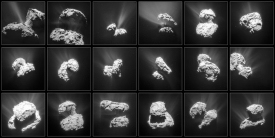 |
| Comet activity 31 January - 25 March 2015. Credit: ESA/Rosetta/NAVCAM, CC BY-SA IGO 3.0 |
What happens to the comet during perihelion? Will there be a big difference in activity in the coming weeks?
The comet's activity has been growing over the last year that Rosetta has been at the comet. This is an incremental process brought about by the increase in solar energy incident on the comet, warming up its frozen ices that subsequently sublimate. Rosetta has been witnessing this gradual rise, and scientists expect that this activity will reach a peak during August and September. Outbursts are possible, but unpredictable.
Other comets plunge into the Sun at perihelion, what about this one?
Comet 67P/Churyumov-Gerasimenko does not get close enough to the Sun to be destroyed by it; its closest point is actually further than Earth ever gets to the Sun and, furthermore, the comet has survived many previous orbits. It is not, for example, classed as a 'sungrazer' like Comet C/2012 S1 ISON, which broke apart during its perihelion passage in November 2013.
Will Comet 67P/C-G break apart during perihelion?
The comet has not broken apart during its many previous orbits, so it is not expected to do so this time, but it cannot be ruled out. Scientists are keen to watch the possible evolution of a 500 m-long fracture that runs along the surface of the neck on the comet during the peak activity.
What happens to the comet after perihelion?
As with the last observed perihelia, we expect the comet to continue on its orbit as normal, away from the Sun and back towards the outer Solar System again. Thanks to the heat absorbed during perihelion, the activity is expected to remain high for a couple of months before gently decreasing towards the moderate activity levels seen earlier in the mission, allowing Rosetta to get closer to the nucleus again.
Rosetta and Philae during perihelion
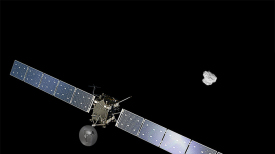 |
| Rosetta approaching comet 67P. Credit: Spacecraft: ESA/ATG medialab; Comet image: ESA/Rosetta/NAVCAM, CC BY-SA IGO 3.0 |
Does Rosetta have to do any special manoeuvres for perihelion?
Perihelion is a very different milestone to the other events such as waking up from hibernation, arriving at or landing on the comet where critical operations had to be carried out. Perihelion is simply a moment in time, and in terms of operations, it is business as usual – no special manoeuvres are required. The mission team hopes to have Rosetta as close as possible to the comet during perihelion to perform science observations without jeopardising the safety of the spacecraft, but this distance is currently decided on a twice-weekly basis for the week ahead, so the exact distance for perihelion is not currently known. During the last few months, it has not been possible to operate closer than 150 km without running into difficulties caused by the vast amounts of dust around the comet at the present time.
Are there any special science observations that will be done at the time of perihelion?
As with operations, it is also business as usual for science observations – monitoring of the comet and its dust, gas and plasma environment will continue during perihelion. Scientists are particularly keen to study the southern hemisphere of the comet, which has been in full sunlight only since May.
How long will it take Rosetta to communicate with Earth on 13 August?
The one-way signal travel time on 13 August is 14 min 44 sec.
When will we see an image from the moment of perihelion?
Rosetta's Navigation Camera takes images several times during each 24 hour Earth day for navigation purposes, while the science camera OSIRIS has dedicated imaging slots. While the imaging schedule is not currently known for perihelion, we are hoping to be able to share both NavCam and OSIRIS image(s) with you from around the time of perihelion, during the afternoon of 13 August. Note that for OSIRIS this will depend on the data prioritisation on that day and the time it takes to downlink so this cannot be guaranteed. Time is also needed to check and process the images for release (for both NavCam and OSIRIS). We will update this section if/when more information about the timing of the image release(s) is known.
Will Rosetta and Philae be safe during perihelion?
Owing to the large amounts of dust, Rosetta will continue to operate at a safe distance from the comet throughout perihelion. We cannot predict any sudden increases in activity of the comet in advance, but the spacecraft safety remains – as always – a priority.
Philae is on the surface of the comet, although its exact location remains unknown. Having regained communications with Rosetta on 13 June the link has been unpredictable and intermittent. The mission teams are carefully analysing the situation and hope that Philae will be operational during perihelion (separate updates on Philae's condition will be made via the Rosetta Blog).
What will happen to the mission after perihelion?
Rosetta will continue to follow the comet as it moves back towards the outer Solar System, watching how the activity decreases over time and monitoring any post-perihelion changes that may occur. The Rosetta mission is scheduled to continue until September 2016, when the nominal planning would see Rosetta spiral down to the surface of the comet, where operations would likely end.
Observing the comet from Earth during perihelion
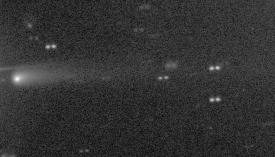 |
| Comet 67P/C-G from Earth - 22 May 2015. Credit: Colin Snodgrass/Alan Fitzsimmons/ESO |
Why is perihelion interesting for astronomers?
Near perihelion, comets reach their highest level of brightness, releasing large amounts of gas and dust. Possible outbursts and other unpredictable events might also take place around perihelion, so it is extremely important to obtain as many observations as possible during this period. While ground-based observations provide large-scale context for Rosetta's measurements, Rosetta's close-up data provide in turn the possibility to calibrate many of the observations made from the ground. This unique opportunity will also improve the study and interpretation of ground-based observations of other comets.
How close to Earth will the comet be at perihelion? Is this the closest it gets to Earth?
While the distance between the comet and the Sun decreases steadily until perihelion, before increasing again afterwards up to aphelion, the distance between Earth and the comet depends on their relative positions in the Solar System. At perihelion, the comet is 265 million km from Earth, but it will be closer (222 million km) during January–February 2016. Follow the positions of Rosetta and the comet through the Solar System using our Where is Rosetta? tool.
Will astronomers be observing the comet at perihelion?
Yes, a large network of professional and amateur astronomers has been observing the comet from across the globe in the past months. Observations with professional telescopes are planned every night around perihelion, relying on several robotic telescopes in many locations, and spectroscopic observations will be performed once a week. More details of the professional campaign are available here.
How can I observe the comet at perihelion?
Unfortunately, even at perihelion, the comet is too faint to be seen with the naked eye. To observe the comet, you will need a good telescope: a minimum of a 20 cm-aperture telescope is recommended. Guidance on how amateur astronomers can observe the comet is available here.
Until when is it possible to observe the comet from Earth?
The comet is currently passing from the southern sky to the northern sky, so its visibility depends on where you live. Around the time of perihelion, it can be observed from Earth in the early morning hours, just before sunrise. It will remain relatively close to the Sun in the sky, and thus observable in the early morning, for several months. Then, the comet will be in the night sky between December 2015 and March 2016, which will be the prime time for ground-based observations. By the middle of 2016 it will likely be too faint to see except by large telescopes owing to its distance from the Sun and Earth, and it will also start moving behind the Sun as seen from Earth.
Media
Will there be any special events to mark the occasion of perihelion?
Members of the public and media are invited to join an online Google+ Hangout on 13 August, during which we hope to have one or more images on the ground from around the time of perihelion. Time and guests to be announced nearer the time.
How can I follow online?
You can follow the mission in a number of ways (see esa.int/rosetta for an overview). On Twitter, official updates will be made by @ESA_Rosetta using the hashtag #perihelion2015. Information will also be provided by the Rosetta blog and on the Rosetta Mission Facebook page. The image(s) from perihelion will be published on our main ESA web portal, esa.int, in an official press release. The Google+ Hangout will also be advertised on esa.int and will be available to watch live via ESA's G+ page and later as a replay on G+ and ESA's YouTube channel.
About Rosetta
Rosetta is an ESA mission with contributions from its Member States and NASA. Rosetta's Philae lander is contributed by a consortium led by DLR, MPS, CNES and ASI.
